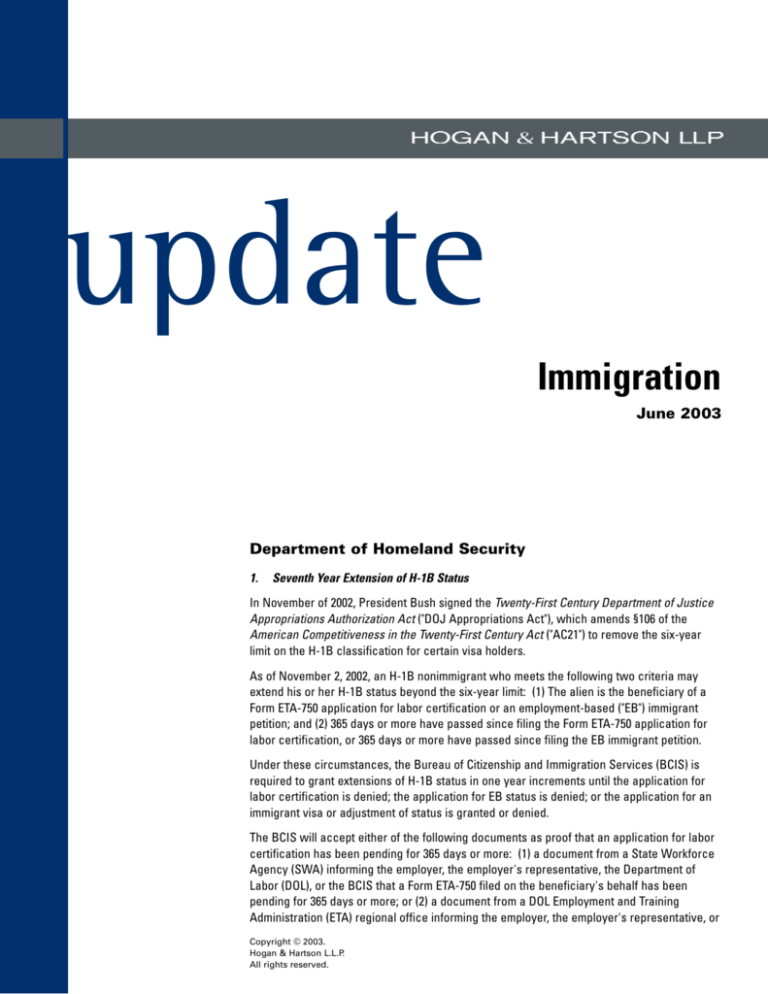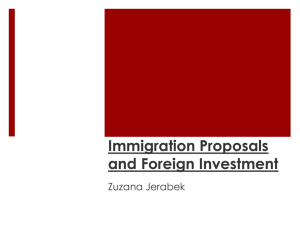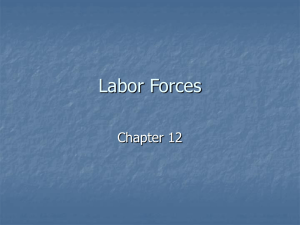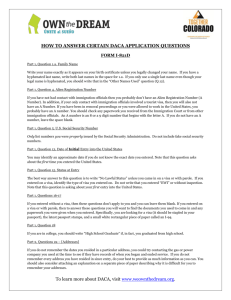
update
Immigration
June 2003
Department of Homeland Security
1.
Seventh Year Extension of H-1B Status
In November of 2002, President Bush signed the Twenty-First Century Department of Justice
Appropriations Authorization Act ("DOJ Appropriations Act"), which amends §106 of the
American Competitiveness in the Twenty-First Century Act ("AC21") to remove the six-year
limit on the H-1B classification for certain visa holders.
As of November 2, 2002, an H-1B nonimmigrant who meets the following two criteria may
extend his or her H-1B status beyond the six-year limit: (1) The alien is the beneficiary of a
Form ETA-750 application for labor certification or an employment-based ("EB") immigrant
petition; and (2) 365 days or more have passed since filing the Form ETA-750 application for
labor certification, or 365 days or more have passed since filing the EB immigrant petition.
Under these circumstances, the Bureau of Citizenship and Immigration Services (BCIS) is
required to grant extensions of H-1B status in one year increments until the application for
labor certification is denied; the application for EB status is denied; or the application for an
immigrant visa or adjustment of status is granted or denied.
The BCIS will accept either of the following documents as proof that an application for labor
certification has been pending for 365 days or more: (1) a document from a State Workforce
Agency (SWA) informing the employer, the employer's representative, the Department of
Labor (DOL), or the BCIS that a Form ETA-750 filed on the beneficiary's behalf has been
pending for 365 days or more; or (2) a document from a DOL Employment and Training
Administration (ETA) regional office informing the employer, the employer's representative, or
Copyright © 2003.
Hogan & Hartson L.L.P.
All rights reserved.
the BCIS that a Form ETA-750 filed on the beneficiary's behalf has been pending for 365 days
or more.
Both documents must include the employer's name, the date the Form ETA-750 was filed, the
name of the beneficiary, and the case number for the pending Form ETA-750.
An H-1B visa holder may request an extension based upon a labor certification that has been
pending 365 days or more in the name of another alien, provided that the petitioning employer
offers evidence that the new alien beneficiary is using the labor certification to gain EB
immigrant status. Applicants have 35 days to appeal denials of applications for labor
certifications to the Board of Alien Labor Certification Appeals (BALCA).
2.
DHS Announces New Entry-Exit System
Tom Ridge, the Secretary of Homeland Security, announced the creation of the U.S. Visitor
and Immigration Status Indication Technology System (U.S. VISIT), a new entry-exit system
that will allow the Department of Homeland Security (DHS) to monitor the more than 35
million visitors that pass through the U.S. each year. U.S. VISIT will utilize biometric
identifiers and other recent technological advances to achieve this goal.
The first phase of this program should be implemented by the end of 2003. The initial stage
will concentrate on international airports and seaports. At each location, at least two
biometric identifiers (digital photographs, iris scans, fingerprinting, facial recognition, etc.)
will be used to identify each visitor. In addition, upon entry or exit, information such as the
individual's name, nationality, classification as immigrant or non-immigrant, date of birth,
passport number, country of residence, U.S. visa number, alien registration number, and
address while in the U.S. may be collected. This information will be stored by the DHS and
the Department of State as part of the individual's record with these agencies. These
Departments can then share this information with other law enforcement agencies as well as
with officials at the Bureau of Immigration and Customs Enforcement (ICE), immigration
services offices, and U.S. consular offices.
As the U.S. VISIT program is phased in at all international airports and seaports, and later at
all major land ports of entry, the DHS plans to phase out the National Security Entry-Exit
Registration System (NSEERS). This system requires citizens of 25 countries to be
fingerprinted and registered with the federal government.
3. Clarification of BCIS Interpretation of "Period of Stay Authorized by the Attorney
General" and Maintenance of "Status" in Determining Unlawful Presence
The BCIS Office of General Counsel recently announced two major policy decisions affecting
aliens applying for extensions of stay (EOS) or changes of status (COS). First, when an alien
files a timely EOS or COS application that is later denied, he or she can begin to accrue
unlawful presence from the date of denial of the EOS or COS regardless of whether the alien
filed additional untimely EOS or COS applications. Second, an EOS or COS application filed
by an alien after the applicant's authorized period of admission has expired will not prolong
the alien's "status." These clarifications were issued due to an increase in the number of
applicants submitting multiple filings so as to remain in the U.S. beyond their original period
of lawful admission without accruing unlawful presence.
Pursuant to this guidance, the BCIS explicitly states that filing an EOS or COS will extend the
"period of stay authorized by the Attorney General" but will not extend the period of time that
the alien remains in "status." Therefore, once an alien's original period of admission (as
stated on the alien's I-94) has expired, he or she can no longer file additional EOS or COS
Immigration
|
2
forms, regardless of whether or not that applicant is awaiting adjudication of a timely filed
EOS or COS. Until the timely filed EOS or COS has been adjudicated, the alien remains in a
"period of stay authorized by the Attorney General" and therefore does not accrue time
toward unlawful presence; however, unlawful presence will begin to accrue from the date
that the EOS or COS application is denied. If an EOS or COS application is approved, the
applicant will once again be considered in "status."
It is crucial that any EOS or COS application be filed while the alien is in a lawful period of
stay.
4.
NSC Revises Impact of I-140 Immigrant Petitions on TN Applications
The Nebraska Service Center (NSC) recently indicated that filing an I-140 immigrant petition
no longer constitutes an automatic ground for rejecting a TN petition on the basis of lack of
nonimmigrant intent. The TN visa, which is a product of the North American Free Trade
Agreement (NAFTA), grants immigration status to Mexicans and Canadians performing
activities at a professional level. The TN visa is only available to people seeking temporary
residence in the United States and possessing non-immigrant intent. The dual intent
doctrine, which allows a person to prove nonimmigrant intent in the short-term despite a
long-term intent to immigrate to the United States, has not previously applied to TN
professionals.
Pursuant to this policy change, the filing of an immigrant visa petition on behalf of a TN visa
holder will only be one factor in determining whether he or she possesses nonimmigrant
intent. A petitioning employer still must demonstrate a legitimate, short-term need for the
professional employee's services, as well as the alien beneficiary's intent to return to his or
her native home before returning to the US for permanent residence. The filing of an
application for adjustment of status or for an immigrant visa will continue to signal a lack of
nonimmigrant intent.
5.
Congressman Introduces Legislation to Tighten L-1 Visa Program
The L-1 visa enables multinational corporations with branches or subsidiaries in the United
States to bring foreign workers to their U.S. branches as intracompany transferees
functioning as international managers or executives, or as specialized knowledge workers.
There is no cap on the number of L-1 visa petitions distributed each year, and the L visa
program has fewer restrictions than other immigrant visa classifications.
Some employers have been accused of abusing the L-1 visa program in order to circumvent
caps and wage restrictions on the H-1B visa program. U.S. Representative John Mica (R-FL)
has introduced legislation aimed at closing an alleged loophole in the L visa program,
whereby U.S. companies are able to bring employees from their foreign subsidiaries to the
United States on L-1 visas and then outsource those employees to other U.S. companies. The
Mica bill would prohibit outsourcing of L-1 employees who enter the U.S.
The Mica bill will likely be referred to the House Immigration, Border Security and Claims
Subcommittee.
6.
BCIS Electronic Filing Program for Form I-90 and Form I-765
On May 29, 2003 the BCIS began accepting electronic applications for Employment
Authorization (I-765) and electronic applications to replace Permanent Residence Cards or
"green cards" (I-90). By the end of 2003, the BCIS plans to add e-filing capabilities for six
additional forms: Form I-129, Petition for Nonimmigrant worker; Form I-131, Application for
Immigration
|
3
Travel Document; Form I-140, Immigrant Petition for Alien Worker; Form I-539, Application to
Extend/Change Nonimmigrant Status; Form I-821, Application for Temporary Protected Status;
and Form I-907, Request for Premium Processing.
Although the new e-filing procedures have the potential to make the filing of certain forms
more convenient, more accurate, and more efficient, there are several limitations to the efiling system. Persons living outside the United States cannot e-file, nor can applicants seek
to waive the application fee. Payment of all application fees must be made at the time that
the form is submitted to the BCIS, and can only be made through the electronic transfer of
U.S. funds from a bank account. Credit card payment of the application fee is not currently
available. Also, because several Application Support Centers are not currently able to
collect digital information, applicants in the vicinity of several Application Support Centers
(Charleston, SC; Jackson, MS; New Orleans, LA; St. Croix, VI; and Yakima, WA) must go to the
next closest location to have their photograph and fingerprints taken. Finally, there is some
concern over the fact that through the e-filing procedure, the BCIS will collect data such as
one's photograph, fingerprints and other personal information and will store them
electronically. This information will not only be used to create the requested document for
the applicant, but may also be used by the BCIS at a later date. For a complete list of specific
limitations and eligibility requirements for e-filing Form I-90 and Form I-765, see the
instructions for e-filing these forms, available at
http://www.bcis.gov/graphics/formsfee/forms/eFiling.htm.
For more information, please contact the following Hogan & Hartson attorneys:
M. Beth Peters
Washington, DC
202-637-5837
mepeters@hhlaw.com
Paul W. Virtue
Washington, DC
202-637-5649
pwvirtue@hhlaw.com
www.hhlaw.com
Immigration Update Editor: Natalie S. Tynan
Immigration Update Assistant Editor: Linda E. Kelly
This Update is for informational purposes only and is not intended as basis for decisions in specific situations. This
information is not intended to create, and receipt of it does not constitute, a lawyer-client relationship.
Immigration
|
4





